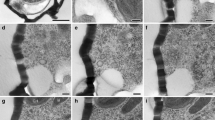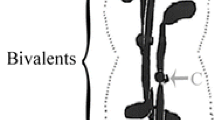Summary
During the development of the spermatogenous cells, the pteridophyteCeratopteris richardii produces three structurally well-defined microtubule organizing centers (MTOCs). The blepharoplast, a spherical body that occurs during the last two spermatogenous divisions, organizes two microtubule (MT) arrays, one associated with a nuclear indentation and the other that organizes the spindle apparatus for the final divisions. After the last spermatogenous division, the blepharoplast reorganizes to produce two new putative MTOCs: the lamellar strip (LS) of the multilayered structure (MLS), which apparently organizes the spline microtubule array, and an amorphous zone (AM), that connects the basal bodies. Thin and semi-thin sections of this tissue were probed with antisera which recognize MTOCs in lower eukaryotes and animals to determine if any of these structures contain MTOC-associated proteins or epitopes recognized by monoclonal antisera. Gamma tubulin antibodies, which recognizeonly the minus ends of MTs in mammalian cells, label along the MT in all arrays found in the pteridophyte spermatogenous cells. Kinetochore MTs are unlabelled near the kinetochore, however. The monoclonal antibodies MPM-2 and C-9, that recognize centrosomal and nuclear epitopes in mammalian cells, label the interphase nucleus, the cytoplasm of mitotic cells, and the blepharoplast during both nuclear indentation and spindle formation. Double labelling of the blepharoplast-containing cells with anti-tubulin and either MPM-2 or C-9 reveals that the blepharoplast-associated fluorescence is the focus of the tubulin arrays. Centrin labels the reorganizing blepharoplast, the MLS, the AM, and a stellate pattern in the transition region of the flagella. These data indicate the usefulness of the structurally well-recognized MTOCs in pteridophyte spermatogenous cells in investigation of land plant MTOCs.
Similar content being viewed by others
References
Baron AT, Salisbury JL (1988) Identification and localization of a novel, cytoskeletal, centrosome-associated protein in PtK2 cells. J Cell Biol 107: 2669–2678
Baskin TI, Busby CH, Fowke LC, Sammutt M, Gubler F (1992) Improvements in immunostaining samples embedded in methacrylate: localization of microtubules and other antigens throughout developing organs in plants of diverse taxa. Planta 187: 405–413
Bornens M (1992) Structure and function of isolated centrosomes. In: Kalnins VI (ed) The centrosome. Academic Press, San Diego, pp 1–43
Chevrier V, Komesli S, Schmit AC, Vantard M, Job D (1992) A monoclonal antibody raised against mammalian centrosomes and screened by recognition of plant microtubule organizing centers, identifies a pericentriolar component in different cell types. J Cell Sci 101: 823–835
Cleary AL (1989) Microtubule organization and nucleation in higher plant cells. PhD Dissertation, Australian National University, Canberra, Australia
—, Hardham AR (1988) Depolymerization of microtubule arrays in root tip cells by oryzalin and their recovery with modified nucleation patterns. Can J Bot 66: 2353–2366
Gunning BES, Hardham AR, Hughes JE (1978) Evidence for initiation of microtubules in discrete regions of the cell cortex inAzolla root-tip cells, and an hypothesis on the development of cortical arrays of microtubules. Planta 143: 161–179
Hardham AR, Gunning BES (1977) The structure of cortical microtubule arrays in plant cells. J Cell Biol 77: 14–43
Harper JDI, Mitchison JM, Williamson RE, John PCL (1989) Does the autoimmune serum 5051 specifically recognize microtubule organizing centers in plant cells? Cell Biol Int Rep 13: 471–483
—, Sanders MA, Salisbury JL (1993) Phosphorylation of nuclear and flagellar basal apparatus proteins during flagellar regeneration inChlamydomonas reinhardtii. J Cell Biol 122: 877–886
Hasezawa S, Nagata T (1993) Microtubule organizing centers in plant cells: localization of a 49 kDa protein that is immunologically cross-reactive to a 51 kDa protein from sea urchin centrosomes in synchronized BY-2 cells. Protoplasma 176: 64–74
Hoffman JC, Mullins JM (1990) Nuclear and mitotically enhanced epitope. Cell Motil Cytoskeleton 16: 68–79
Jarvik JW, Suhan JP (1991) The role of the flagellar transition region: inferences from the analysis of aChlamydomonas mutant with defective transition region structures. J Cell Sci 99: 731–740
Joshi HC, Palacios MJ, McNamara L, Cleveland DW (1992) Gamma tubulin is a centrosomal protein required for cell cycle-dependent microtubule nucleation. Nature 356: 80–83
Kimble M, Kuriyama R (1992) Functional components of microtubule organizing centers. Int Rev Cytol 136: 1–50
Lambert AM (1993) Microtubule-organizing centers in higher plants. Curr Opin Cell Biol 5: 116–122
Lehnen LP, Vaughn KC (1991) Immunofluorescence and electron microscopic investigations of the effects of dithiopyr on onion root tips. Pestic Biochem Physiol 40: 58–67
—, Vaughan MA, Vaughn KC (1990) Terbutol affects spindle microtubule organizing centers. J Exp Bot 41: 537–546
Liu B, Marc J, Joshi HC, Palevitz BA (1993) A gamma tubulin-related protein associated with the microtubule arrays of higher plants in a cell cycle-dependent manner. J Cell Sci 104: 1217–1228
Marc J, Gunning BES (1986) Immunofluorescent localization of cytoskeletal tubulin and actin during spermatogenesis inPteridium aquilium (L.) Kühn. Protoplasma 134: 163–177
Mazia D (1987) The chromosome cycle and the centrosome cycle in the mitotic cycle. Int Rev Cytol 100: 49–92
Moudjou M, Paintrand M, Viguez B, Bornens M (1991) A human centrosomal protein is immunologically related to basal body associated proteins from lower eukaryotes and is involved in the nucleation of microtubules. J Cell Biol 115: 129–140
Oakley CE, Oakley BR (1989) Identification of gamma tubulin, a new member of the tubulin superfamily encoded bymip A gene ofAspergillus nidulans. Nature 338: 662–664
Rao PN, Zhao J, Ganju RK, Ashorn CL (1989) Monoclonal antibodies against the centrosome. J Cell Sci 93: 63–69
Salisbury JL (1989) Centrin and the algal flagellar apparatus. J Phycol 25: 201–206
—, Baron A, Sanders MA (1988) The centrin-based cytoskeleton ofChlamydomonas reinhardtii: distribution in interphase and mitotic cells. J Cell Biol 107: 635–641
Sanders MA, Salisbury JL (1989) Centrin-mediated microtubule severing during flagellar excision inChlamydomonas reinhardtii. J Cell Biol 108: 1751–1760
Smirnova EA, Bajer AS (1992) Spindle poles in higher plants mitosis. Cell Motil Cytoskeleton 23: 1–7
Traas JA, Beven AF, Doonan JH, Cordewener J, Shaw PJ (1992) Cell-cycle-dependent changes in labelling of specific phosphoproteins by the monoclonal antibody MPM-2 in plant cells. Plant J 2: 723–732
Vandré DD, Borisy GG (1989) Anaphase onset and dephosphorylation of mitotic proteins occur concomitantly. J Cell Sci 94: 245–258
—, Davis FM, Rao PN, Borisy GG (1986) Distribution of cytoskeletal proteins sharing a conserved phosphorylated epitope. Eur J Cell Biol 41: 72–81
Vaughn KC, Lehnen LP (1991) Mitotic disrupter herbicides. Weed Sci 39: 450–457
—, Campbell EO, Hasegawa J, Owens HA, Renzaglia KS (1990) The pyrenoid is the site of ribulose bisphosphate carboxylase/ oxygenase accumulation in the hornwort (Bryophyta: Anthocerotae) chloroplast. Protoplasma 156: 117–129
—, Sherman TD, Renzaglia KS (1993) A centrin homologue is a component of the multilayered structure in bryophytes and pteridophytes. Protoplasma 175: 58–66
Wick SM (1985) The higher plant mitotic apparatus: redistribution of microtubules, calmodulin and microtubule initiation material during its establishment. Cytobios 43: 285–294
— (1990) Localization of calcium-binding proteins in dividing plant cells: In: Leonard RT, Hepler PK (eds) Calcium in plant growth and development. American Society of Plant Physiologists. Rockville, MD, pp 137–143
Zhang D, Wadsworth P, Hepler PK (1990) Microtubule dynamics in living dividing plant cells: confocal imaging of microinjected fluorescent brain tubulin. Proc Natl Acad Sci USA 87: 8820–8824
Author information
Authors and Affiliations
Rights and permissions
About this article
Cite this article
Hoffman, J.C., Vaughn, K.C. & Joshi, H.C. Structural and immunocytochemical characterization of microtubule organizing centers in pteridophyte spermatogenous cells. Protoplasma 179, 46–60 (1994). https://doi.org/10.1007/BF01360736
Received:
Accepted:
Issue Date:
DOI: https://doi.org/10.1007/BF01360736




